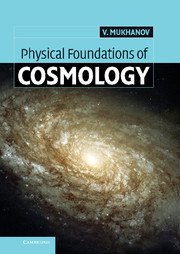Book contents
- Frontmatter
- Contents
- Foreword by Professor Andrei Linde
- Preface
- Acknowledgements
- Units and conventions
- Part I Homogeneous isotropic universe
- Part II Inhomogeneous universe
- 6 Gravitational instability in Newtonian theory
- 7 Gravitational instability in General Relativity
- 8 Inflation II: origin of the primordial inhomogeneities
- 9 Cosmic microwave background anisotropies
- Bibliography
- Index
6 - Gravitational instability in Newtonian theory
from Part II - Inhomogeneous universe
Published online by Cambridge University Press: 05 September 2012
- Frontmatter
- Contents
- Foreword by Professor Andrei Linde
- Preface
- Acknowledgements
- Units and conventions
- Part I Homogeneous isotropic universe
- Part II Inhomogeneous universe
- 6 Gravitational instability in Newtonian theory
- 7 Gravitational instability in General Relativity
- 8 Inflation II: origin of the primordial inhomogeneities
- 9 Cosmic microwave background anisotropies
- Bibliography
- Index
Summary
Measurements of the cosmic microwave background tell us that the universe was very homogeneous and isotropic at the time of recombination. Today, however, the universe has a well developed nonlinear structure. This structure takes the form of galaxies, clusters and superclusters of galaxies, and, on larger scales, of voids, sheets and filaments of galaxies. Deep redshift surveys show, however, that when averaged over a few hundred megaparsecs, the inhomogeneities in the density distribution remain small. The simple explanation as to how nonlinear structure could develop from small initial perturbations is based on the fact of gravitational instability.
Gravitational instability is a natural property of gravity. Matter is attracted to high-density regions, thus amplifying already existing inhomogeneities. To ensure that the small initial inhomogeneities present at recombination produce the nonlinear structure observed today, we have to study how fast they grow in an expanding universe. The complete general relativistic analysis of gravitational instability is rather involved and the physical interpretation of the results is not always straightforward. For this reason we develop the theory of gravitational instability in several steps.
In this chapter we consider gravitational instability in the Newtonian theory of gravity. The results derived in this theory are applicable only to nonrelativistic matter on scales not exceeding the Hubble horizon. First, we find out how small inhomogeneities grow in a nonexpanding universe (Jeans theory). The main purpose here is to determine which types of perturbations can exist in homogeneous, isotropic media, and to introduce methods to analyze them.
- Type
- Chapter
- Information
- Physical Foundations of Cosmology , pp. 265 - 288Publisher: Cambridge University PressPrint publication year: 2005



